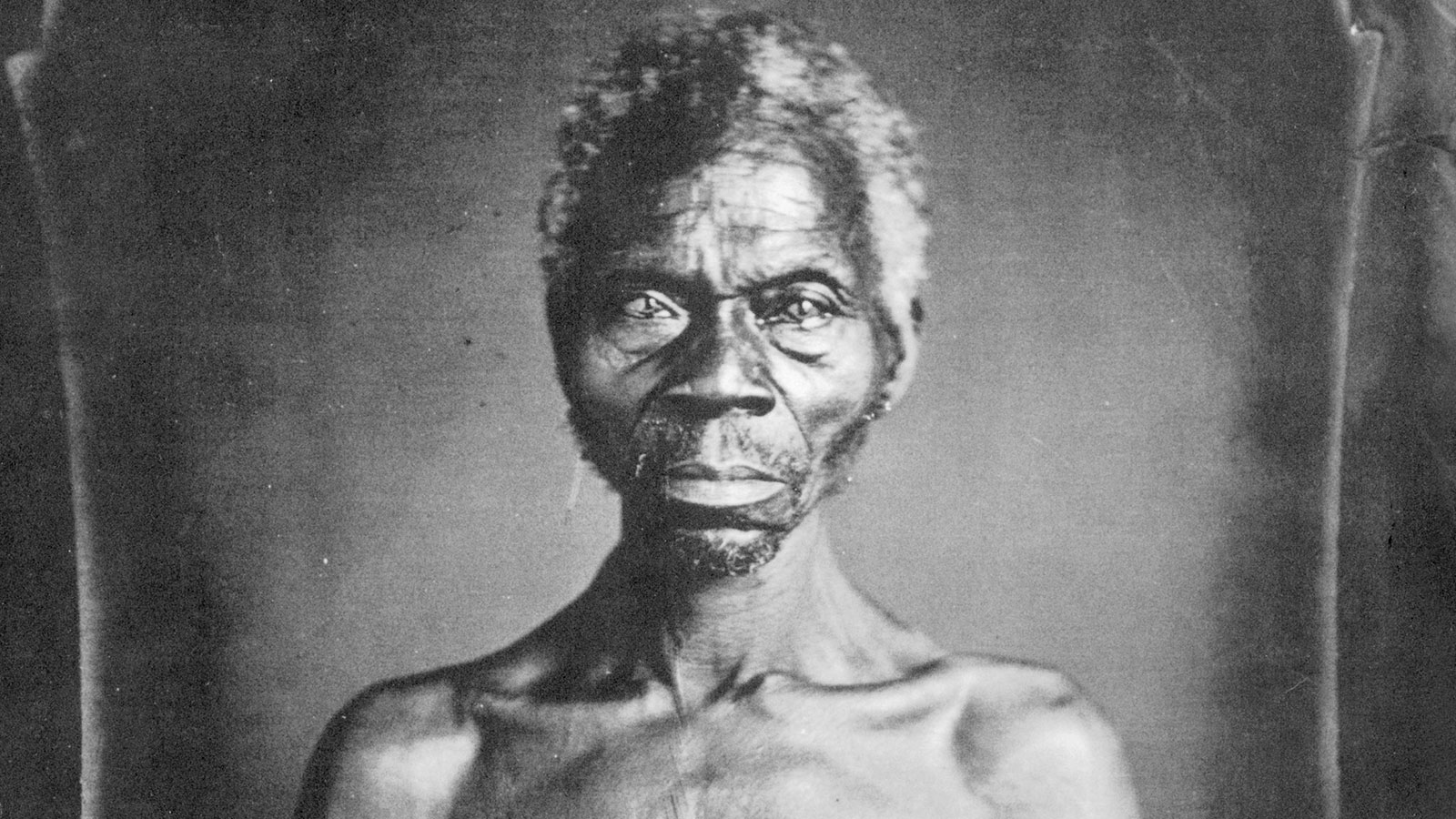The images are among the oldest known photographs of enslaved people in America. Tamara Lanier’s fight to gain control of them shows there is no clear system in place to repatriate remains of captive Africans or objects associated with them.
By Jennifer Berry Hawes, Pro Publica —
The woman turned her car onto the campus of Harvard University, a place she had never been, and parked near a museum renowned for its invaluable cultural artifacts. But on that day in 2010, Tamara Lanier did not come to see ancient Mayan murals or African masks. She arrived to view historic photographs of enslaved people she had recently come to believe were her own ancestors.
Though excited, she steeled herself. She had seen the images online. She had felt gripped by the steely gaze of a man named Renty. And she had grieved for his daughter, a young woman named Delia, seated with the top of her dress unbuttoned, pulled down and bunched in her lap. Tears blurred her eyes.
Photography was a fairly new technology back in 1850 when a group of white men 1,000 miles away from Cambridge, Massachusetts, conspired with a famous Harvard professor to use it. Louis Agassiz, a pioneer of natural science, had traveled to South Carolina hoping to prove that different races did not share a common origin, a theory called polygenesis.
To aid his effort, the men had selected seven Black people, most from nearby plantations, and hauled them to a posh photo studio in downtown Columbia. Someone forced the seven to partly or fully undress before a camera. A photographer then captured them from the front, side and back like the specimens Agassiz considered them to be.
Now, 173 years later, Harvard’s Peabody Museum of Archaeology and Ethnology holds within its vast collection the resulting 15 images, a kind of early photograph called daguerreotypes. They are among the oldest known photographs of enslaved people in America.
When Lanier entered the Peabody that day, after driving for two hours from her home in Connecticut, she clutched a document she’d prepared for Harvard in hopes its experts might review it with her. It detailed the genealogy research she thought could demonstrate her ancestral ties to Renty and Delia. A white woman who would oversee her visit greeted her, in what Lanier recalled as a professional but distant tone. Lanier signed a standard legal form that stated if she was allowed to examine anything in the museum’s archives, she would need permission to publish any part of it.
Then she relinquished her purse and cellphone and anything in her pockets. She had come expecting to feel welcome as a potential descendant. A longtime probation officer, she instead felt like she was entering a prison.
The experience left her shaken. Over the next nine years leading up to her 2019 lawsuit against Harvard to gain control of the photographs, Lanier grew increasingly offended by its dominion over them. As she attempted to get Harvard to engage with her, she grappled with nausea and insomnia. She found it outrageous that the institution whose celebrated employee prompted the taking of the pictures controls the stories of the people he subjected to such degradation.
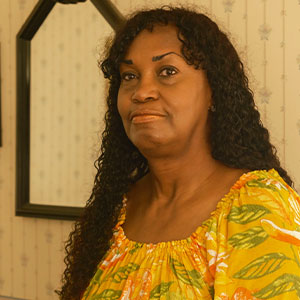
Tamara Lanier at her home in Connecticut. Credit: Arielle Gray for ProPublica
“Harvard has ruled over them with an iron fist,” Lanier said. “But this ugly history will always be in the way of anything they try to do with these images.”
Yet she has little recourse.
Last year, the Massachusetts Supreme Judicial Court agreed with a lower court that had dismissed Lanier’s claim to ownership of the photos. The justices ruled in part that no legal avenue allows descendants to obtain possession of artifacts that resulted from their ancestors’ enslavement. (The court did allow her to pursue an emotional distress action in which she accuses Harvard of “publicly and cavalierly dismissing her claim of an ancestral connection to Renty and Delia.” Harvard denies this claim — and that she has proven she is a lineal descendant. That case is pending.)
As Justice Elspeth Cypher noted during oral arguments, “There are systems in place for repatriating remains for Native Americans and their objects. We unfortunately don’t have something in place through Congress to do that for African Americans and descendants.”
Cypher was referring to the 1990 Native American Graves Protection and Repatriation Act, or NAGPRA. ProPublica has been investigating the failure of federally funded museums, including the Peabody, to repatriate their holdings of Native American remains and artifacts under the law.
Among other things, NAGPRA allows lineal descendants of Native people who owned certain objects to pursue their return. But enslaved ancestors couldn’t own property — they were the property.
And because they were treated as property, exhuming enough records to clearly connect generations of enslaved ancestors also borders on the impossible, as Lanier has discovered during her 13-year odyssey.
But more is at stake than who gets to claim “ownership,” a fraught concept in a battle over coerced pictures taken of captive people. Lanier’s ultimate goal is not to possess the images for herself but to reclaim a story. She sees revealing the brutality of the imagery, and the humanity of the subjects, as being as important to the broader understanding of the nation’s legacy of slavery as the images themselves.
“She is involved in a conversation that goes to many broader issues of African American empowerment — and disempowerment — in the telling of their own story,” said Michael Blakey, a bioarchaeologist and professor at the College of William & Mary and co-chair of The Commission for the Ethical Treatment of Human Remains of the American Anthropological Association.
Lanier’s quest is about finding a rightful steward to make decisions over the handling of the photographs and how they are presented. She has a new potential home in mind, one that she feels would finally set the people captured in them free.
“Write This Down”
Before she’d ever heard of the daguerreotypes, Lanier had learned from her mother about the Rentys of her family. Mattye Thompson Lanier was born in the 1920s to sharecropper parents in rural Mount Meigs, Alabama, where she heard stories handed down by her grandfather, a cotton farmer born into slavery in South Carolina.
His name was Renty Thompson, and he hailed from a line of enslaved men named Renty.
They began with an African-born man called Papa Renty, who held a place of special reverence to the family in part because he had taught himself to read English, and then taught others, at great personal risk. Teaching enslaved people to write was illegal.
Mattye absorbed her grandfather’s oral history with determination that the legacy of Papa Renty and the generations that followed him not be forgotten. Throughout the Montgomery bus boycott, her brother Renty, who went by “Willie,” walked to his plumber job every day. For long after, he kept the worn and broken shoes with pride, calling them his “civil rights shoes.”
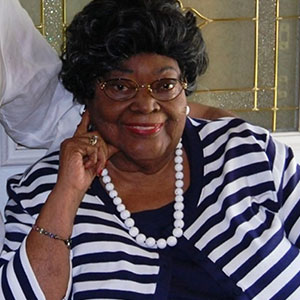
Mattye Thompson Lanier in 2009. Courtesy of Tamara Lanier
Mattye treasured those stories. As she lay dying in 2010, she grew insistent with her daughter: “I want you to write this down.”
Lanier agreed. With the younger of her two daughters in college, and retirement from her job as a chief probation officer on the horizon, she figured that she’d soon have more time to preserve this oral history. In reality, she had no idea of all that her promise would entail.
Shortly after her mother’s death, Lanier stopped by a sandwich shop she frequented and mentioned to its owner the promise she had made and the man called Papa Renty.
When Lanier returned another day, the shop owner beamed: “I found your Papa Renty on the internet!” He emailed her a link, which she opened at home that night. Staring back in the daguerreotypes was Renty, who appeared to be about 70 at the time. She felt her eyes lock on his.
“I knew in my heart that this was the man I’d heard about for so many years,” said Lanier, who’s now 60.
The shop owner had sent her two links. The second one pulled up a story that mentioned Louis Agassiz. Among the most acclaimed scientists of his time, Agassiz founded Harvard’s Museum of Comparative Zoology and was the first scientist to hypothesize a global ice age. But Lanier also read that after encountering Black hotel workers one day, the Swiss-born professor had written to his mother that he “experienced pity at the sight of this degraded and degenerate race” and found it “impossible for me to reprocess the feeling that they are not of the same blood as us.”
In early 1850, Agassiz traveled south to address a scientific conference in Charleston, where he voiced support for polygenesis. Then he headed inland past vast cotton plantations toward South Carolina’s capital city of Columbia. His cohorts there included Robert Gibbes, a paleontologist and physician to the wealthy plantation operators who facilitated Agassiz’s field research.
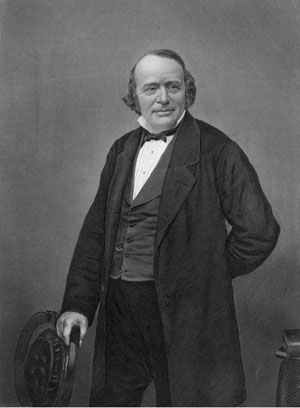
An engraved portrait of Louis Agassiz circa 1850. Getty Images
The seven enslaved people soon faced a camera. All five men were African-born. Along with Renty and Delia were Jack and his daughter, Drana. The other men were Alfred, Fassena and Jem.
It is unclear whether Agassiz directed the photography in person. But a few months later, he wrote in the Christian Examiner that he had recently “examined closely many native Africans belonging to different tribes.”
As she read, Lanier grew convinced these were pictures of her own family members.
Her family called Papa Renty the Black African because he was African-born. And although Lanier’s mother grew up in Alabama, Renty Thompson, Lanier’s great-grandfather, was born in South Carolina. Mattye Thompson Lanier called one branch of their family the “Carolina Geechees.”
How many men named Renty, African-born, were held in bondage at the time in South Carolina? Likely not many. Renty wasn’t an especially common name in slave inventories. And a dwindling number of African-born captives remained alive at the time given four decades had passed since Congress banned the importation of enslaved people.
This has to be the same man, Lanier thought.
She set out to prove it.
In Search of Renty
In 1855, Frederick Douglass lamented how little he knew of his parents or the time of his birth: “Genealogical trees do not flourish among slaves,” he wrote. No enslaved person he’d ever met could relay a birthdate. Life and law routinely tore fathers from children. Mothers marked births by seasons and harvests too soon forgotten.
“They keep no family records, with marriages, births, and deaths,” Douglass wrote.
African Americans researching ancestors today often hit an archival black hole before the end of the Civil War in 1865. The 1870 federal census is the first one that even records all formerly enslaved people with their names.
Despite having no experience searching archives, Lanier began to scour census, death and probate records. For 13 years now, she has worked to craft a narrative about her lineage. It fills three-ring binders, Google and Word documents, timelines and spreadsheets.
“When I talk about a jigsaw puzzle from hell,” she said, “that’s what it has been like.”
Lanier was luckier than most. Her mother had passed on a fairly detailed oral history. And despite the disturbing nature of the daguerreotypes, they yielded important clues. Gibbes had jotted onto scraps of paper a few words about each person photographed.
Inside one velvet-lined leather case about the size of a cell phone, a frame holds a photograph of Renty in profile. The note affixed to the lining facing it reads: “Renty. Congo.” Below that, Gibbes added, “B.F. Taylor Esq. Columbia S.C.”
In fact, it appeared that four of the seven people photographed — Renty, Delia, Jack and Drana — were associated with B.F. Taylor. Knowing who enslaved them would be hugely helpful because morsels of detail about human property linger among the preserved letters, receipts and estate records kept by white elites.
Lanier easily identified B.F. Taylor. He was Benjamin Franklin Taylor, part of a family of Columbia-area plantation owners who bore titles like colonel and governor. Indeed, the names Renty and Delia showed up on several of the Taylors’ slave inventories, which were filed with their probate records. Although these handwritten lists yielded only captive people’s first names and dollar values, they provided Lanier glimpses into their locations and the names of family and friends around them.
One such inventory, filed after the 1833 death of Benjamin Taylor’s father, Col. Thomas Taylor, became a backbone of Lanier’s research because it listed two men named Renty and grouped people by family units. One Renty headed a group of seven who included Delia. The other man, called Big Renty, was listed above two people.
Nothing in the inventory obviously links the two family units. They don’t appear near each other on the page, but another Taylor document named a person from each group as siblings, bolstering Lanier’s view that they were in fact one family.
She posits that Big Renty is her Papa Renty, evidenced by the Black family tradition of referring to a father whose son shares his name as Big Jim or Big George. She contends the two Rentys in the inventory are father and son — her Papa Renty and his son Renty Taylor, the name of Renty Thompson’s father. (Lanier still doesn’t know how Renty Thompson got his last name. He might have been sold to a Thompson or, as a freed man, chosen the surname.)
Someone else on the Taylor inventory, listed with a separate family unit, also caught her eye: a person named Tena.
Renty Thompson’s mother was named Tena Taylor.
Was it mere coincidence?
Lanier found little to connect Renty Taylor, her great-great-grandfather, to Alabama. But Tena Taylor, her great-great-grandmother, clearly was born in South Carolina and moved, at some point, to Mount Meigs, Alabama, a rural area where she lived and died — as did Renty Thompson.
What also became clear: Benjamin Taylor and his immediate family enslaved several women with variations of the name Tena. And when a slew of Taylor’s brothers and nephews left Columbia to extend their plantation riches, where did they move? Mount Meigs, Alabama. One of them bought Chantilly Plantation in the Pike Road area, near where Lanier’s family later lived.
The Taylors surely brought with them the people they kept in bondage. And that could explain why, as Lanier’s mother had said, Tena Taylor traveled back and forth between South Carolina and Alabama to visit loved ones after she was freed.
But making a definitive case about the connections between all of these people is difficult without more documentation. Adequate records might not even exist. Gregg Hecimovich, an author and English professor, has spent more than a decade researching the seven people in the daguerreotypes and contributed a chapter to a 2020 book of scholars’ essays about them. He described “stalking the vapory trail” left by all seven.
“The people behind the images embody, to my mind, mini-histories of the American experience, only this time a history that white Americans willfully tried to erase, and still try to bury,” said Hecimovich, who teaches at Furman University, northwest of Columbia, and is finishing work on a book about the seven during a year-long fellowship at Harvard.
The research continues, although for Lanier it is not only an academic pursuit.
“So many people like me are out there trying to piece their families back together,” she said. “There is always this yearning. You’re driven to keep digging and keep searching.”
After 1865, a paper trail begins to illuminate the lives of newly freed people.
The 1870 census shows an 86-year-old man named Renty living in Columbia with people whose names also appeared on Benjamin Taylor’s slave inventory. This Renty was African-born, a distinct rarity by then. It likely means that the man whose visage has come to define the daguerreotypes lived to experience freedom again.
Who Tells the Story?
Lanier’s odyssey is a case study for scholars and lawmakers who have called on Congress to adopt protections akin to NAGPRA that would provide African Americans a path to seek repatriation — an AAGPRA, if you will.
“Where is the same consideration for the descendents of American chattel slavery?” Lanier asked. If she’d had a framework to pursue control of the daguerreotypes, perhaps she and Harvard might have avoided ongoing litigation and years of public conflict.
“Giving museums and communities no legal tools, no set of processes to navigate these problems leaves everyone shortchanged,” said Chip Colwell, an anthropologist who wrote the book “Plundered Skulls and Stolen Spirits: Inside the Fight to Reclaim Native America’s Culture.” In 2021, he co-authored a call for an AAGPRA in Naturemagazine.
But because enslaved people faced a particular degree and type of harm, an AAGRPA would need substantial differences from its namesake.
For instance, tribal governments often make repatriation claims under NAGPRA by citing their ties to the lands that ancestral remains and items were taken from. That wouldn’t work for African Americans whose enslaved ancestors were typically stripped of such basic rights as owning land.
“The abject denial of humanhood and all of the rights that come with that during this period does make it incredibly different,” said Tonya Matthews, president and CEO of the International African American Museum in Charleston, which has a genealogy center. “The challenge is you’re dealing with the history of a people who were deliberately mishmashed together but also constantly separated.”
Despite the difficulty that has created for descendants researching their family histories, Harvard has countered Lanier’s efforts largely by asserting that she hasn’t proven a direct link to Renty or Delia. Harvard spokesperson Nicole Rura told ProPublica that experts within the university, and one outside, have examined Lanier’s claims of lineage “and we have not been able to find a connection between Ms. Lanier and the individuals in the daguerreotypes.”
Museums, she added, cannot just accept at face value a person’s claim of lineage to items in a collection — especially when, as in Lanier’s case, the person has sued to gain control of the items as a direct descendant.
“Harvard of course recognizes that there are practical limitations that encumber exhaustive genealogical research related to African American lived experiences,” Rura said in an email. “But at the same time, educational institutions and museums obviously cannot automatically accept claims of ancestry.”
Lanier wondered how the university examined her evidence of lineage, which she insisted is strong, given nobody from Harvard had sat down with her to review her ongoing research. (Rura said Harvard invited Lanier to share her additional findings multiple times.)
To Lanier, Harvard officials’ treatment of her is indicative of the problem she is pointing out: Rather than actively engage with her as even a potential descendant, she contends, they have preferred their own narrative told by people of their choosing.
“Beyond the academic arrogance, it is just a denial of Renty and Delia’s basic humanity — their history, their legacy,” she said. “It is a perfect example of cultural appropriation.”
Even if Lanier cannot definitively prove she is their direct descendant, she would have a stronger case if the threshold was only that she had to prove she is related to the community of people who were enslaved by the Taylors.
Instead of emphasizing direct descendants seeking repatriation, an AAGPRA would need to rely more on such “descendant communities,” Blakey said. He pointed to a national rubric on best practices that defines these communities as the families of people enslaved at a certain site or a surrounding region, or people who feel connected regardless of a proven genealogical tie.
“That community piece — who it is, what sort of authority the lineal descendants have compared to people who claim to be historical, social, spiritual descendants — that’s something we are going to have to work out” as a society, said Rachel Watkins, a biocultural anthropologist and department chair at American University.
Many museums don’t even know what human remains and objects they possess related to African Americans because they kept such poor records regarding people they viewed as research objects. No central repository tracks them either. An AAGPRA could require that museums review their collections and then publicly report what they have, allowing for more accountability.
NAGPRA requires federal agencies and museums to do just that for human remains and items that were taken from Native American graves. As institutions have completed these inventories, sometimes while also embarking on racial reckonings, they have reported finding remains and items connected to African Americans as well.
In 2021, Harvard’s then-president, Lawrence S. Bacow, issued a stunning announcement: Harvard had cataloged the remains of more than 22,000 human beings in its collections. They included the remains of 15 people of African descent who might have been enslaved. (This number has since grown to 19.)
“These individuals represent a chapter in our history that we must confront,” Bacow wrote. He apologized for “Harvard’s role in collection practices that placed the academic enterprise above respect for the dead and human decency.”
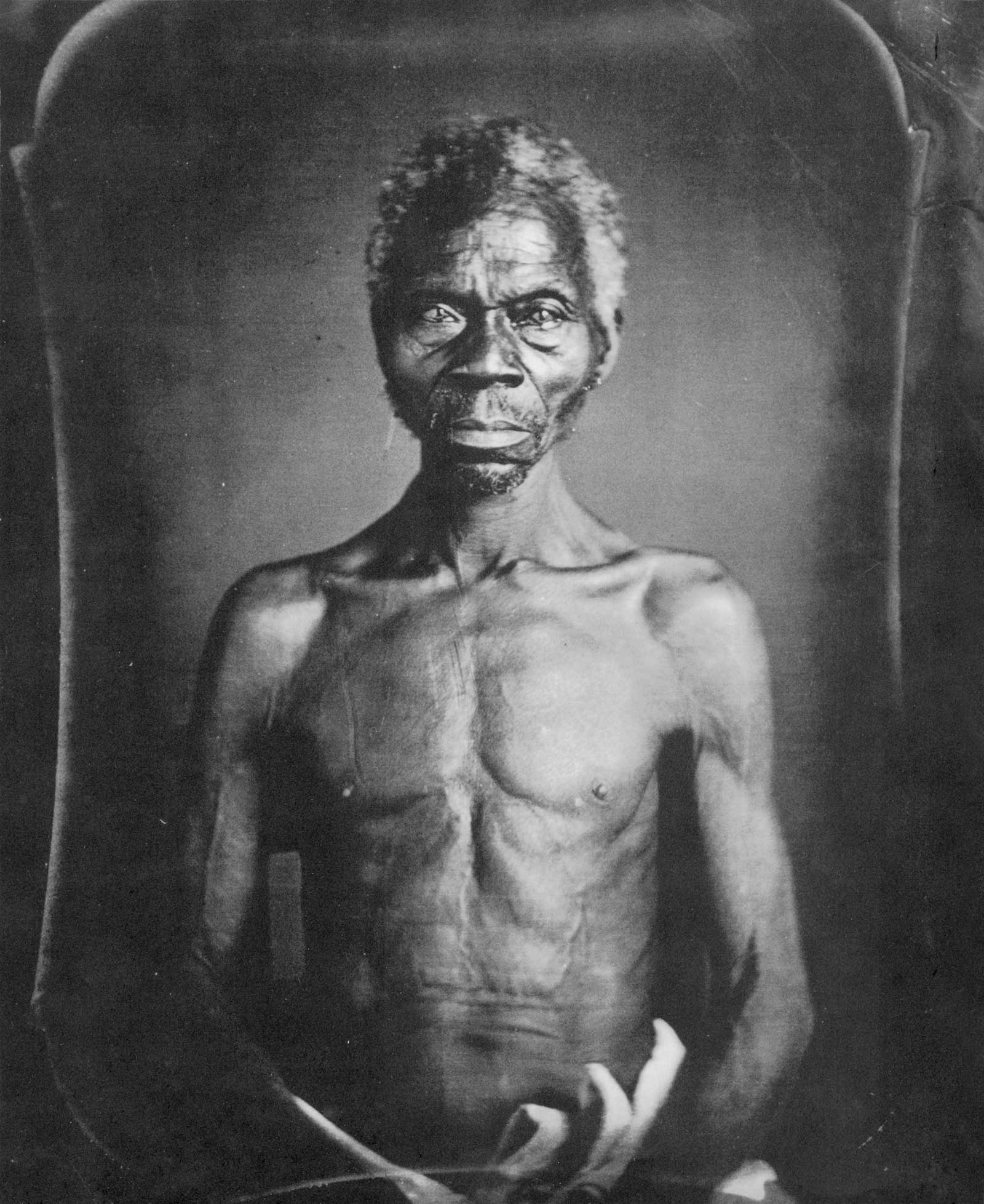
Renty an African slave, subject of Louis Agassiz. Wikimedia Commons
With Hope of a Homecoming
In March, Lanier stood gazing at the waters where a wharf once reached into Charleston Harbor to greet a glut of slave ships. Beneath her feet lay an artist’s carvings of the outlines of bodies resembling captives stuffed into those vessels’ hulls. It is possible that some or all of the five African-born men subjected to the photography arrived into enslavement here.
Lanier turned away to head inside a new 150,000-square-foot homage to the Black experience. The International African American Museum opened in June, but Lanier was getting a sneak peek with faculty from the College of Charleston’s Center for the Study of Slavery. In a few hours, she would give a talk at the college about her journey.
She never imagined the promise she made to her mother would lead to people across the country seeking out her story — and those of Renty and Delia. A movement dubbed Free Renty had sprung up around her quest. Students at Harvard had backed her. So had 43 of Louis Agassiz’s descendants, who signed a letter supporting her efforts. In 2019, two had even marched with her to the president’s office to hand-deliver a copy.
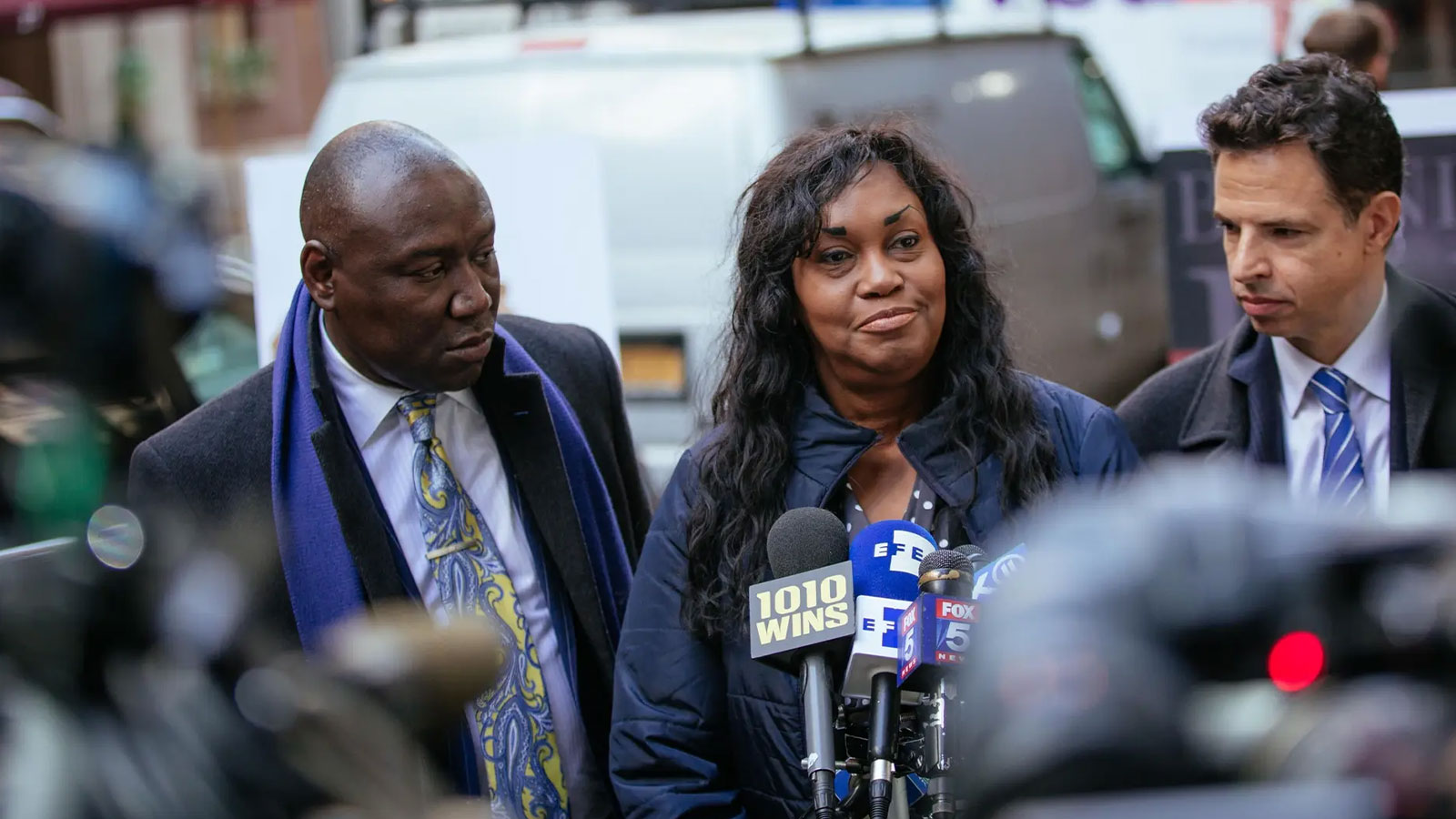
Lanier, center, speaks during a press conference announcing a lawsuit against Harvard University outside the Harvard Club of New York City in March 2019. Credit: Kevin Hagen/Getty Images
Now she walked up the wide front steps to this grand new museum in the state where Renty and Delia had lived and probably died. Wandering among its galleries, she examined shackles that once held people in bondage, tools that Black midwives used to birth new life and baskets woven by enslaved women who brought the skill from their homes in West Africa. She paused in one room to read walls filled with people’s first names like so many she had seen on slave inventories during her research.
“Maybe Harvard should fund the caring for the daguerreotypes here,” she mused. Bringing the images to South Carolina, to a “first voice” institution like this one — an African American-led museum telling African American stories — would mark what Lanier described as “a homecoming.”
Three months later, on July 1, Harvard welcomed its first Black president. Claudine Gay, professor of African and African American Studies, is the daughter of Haitian immigrants. Following her selection, ProPublica asked leaders at Harvard and the IAAM what they thought of Lanier’s idea of transferring the images to Charleston.
Rura, Harvard’s spokesperson, didn’t address the IAAM specifically but also didn’t dismiss the idea.
She wrote to ProPublica that “it is Harvard that has long suggested placing the daguerreotypes — all 15 of them — in another institution that would allow them to be more accessible to a broader segment of the public, to be understood in an appropriate historical context, and to tell the stories of the enslaved individuals they depict.”
She added, “It is difficult to arrange for such a transfer while the litigation is pending.”
Matthews, the IAAM’s president, said the museum is equipped to store the images, which are housed at Harvard in custom-made cases in a facility with controlled temperature and humidity. Matthews added that she would welcome a conversation about moving them to her museum, particularly if approached by the holding institution and a descendant.
“It definitely fits within our collection philosophy,” she said. “South Carolina is ground zero for a lot of this.”
The notion of a “homecoming,” she added, resonated with her.
After leaving Charleston, Lanier continued to mull that word, too. It gave her a sense of welcome and comfort. She envisioned a celebration for the daguerreotypes akin to the Black funeral tradition of a homegoing, when loved ones cherish and exalt those who have passed and set their spirits free.
Source: Pro Publica
Jennifer Berry Hawes is a reporter with ProPublica’s South hub who focuses on criminal justice, religion, race and the welfare of women and children.
Mollie Simon contributed research.
Featured image: Renty an African slave, subject of Louis Agassiz. Wikimedia Commons.


